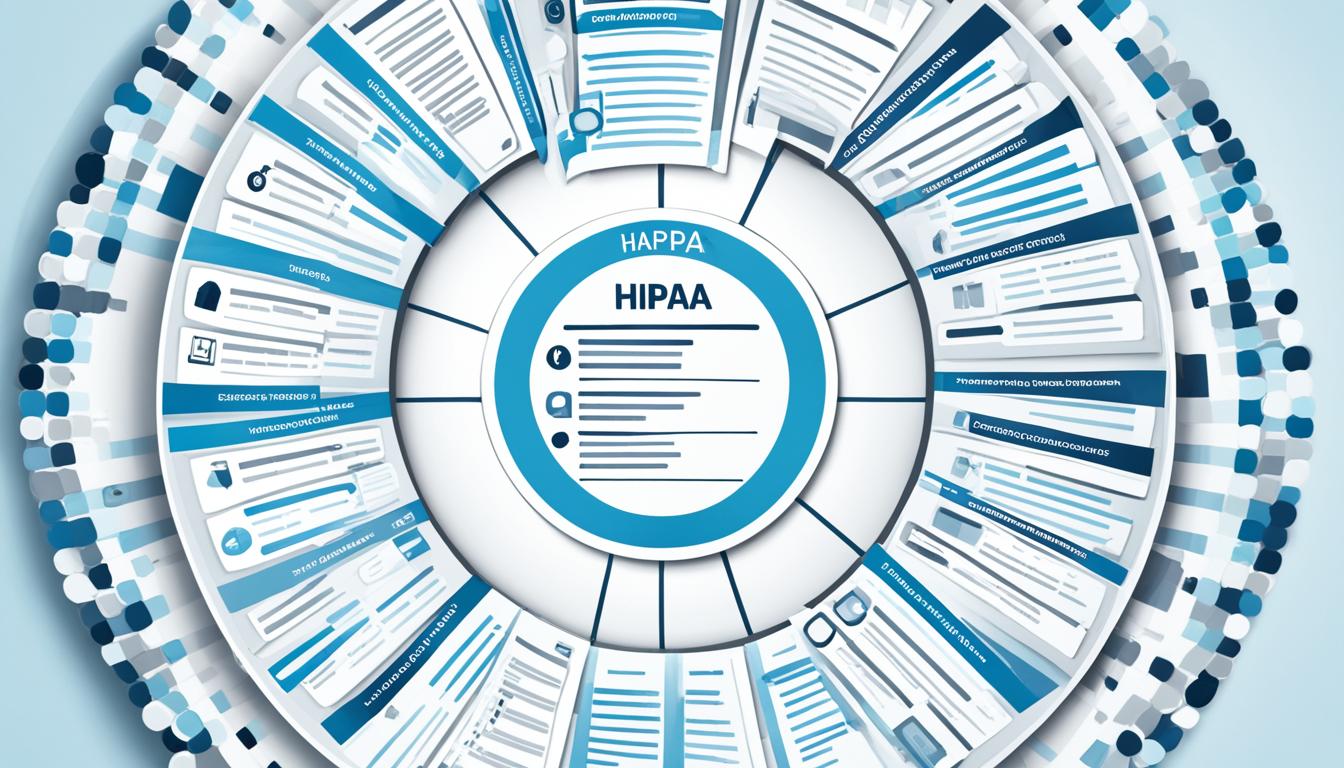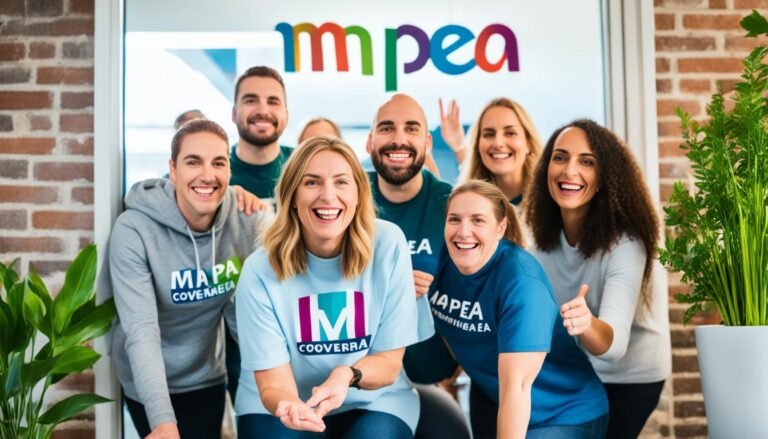HIPAA Compliance: Essential Guide & Tips
Every year, healthcare organizations spend a lot to keep patient information safe. Yet, millions of people still suffer from data breaches. This guide aims to help healthcare groups understand HIPAA rules better. With our advice, organizations can do more than just follow the rules. They can keep patient privacy secure.
If you’re starting or improving your program, HIPAA can seem tough. But with the right info and tools, it’s possible to keep up. This guide makes learning about HIPAA clear and simple. We make sure your efforts are smart and successful.
Key Takeaways
- HIPAA compliance needs ongoing work for constant improvement.
- Good security and training staff well are key to preventing leaks and earning trust.
- It’s vital to know about the Privacy, Security, and Breach Notification Rules for compliance.
- Regular risk checks and strong privacy policies help avoid breaking rules.
- Developing a culture that values compliance is crucial for safeguarding patient data.
- Understanding the roles of involved parties clarifies who is responsible for compliance.
Understanding the Basics of HIPAA Compliance
The Health Insurance Portability and Accountability Act (HIPAA) is key to protecting patient data in healthcare. This section explains HIPAA compliance clearly. It shows how these rules are crucial for keeping patient details private and building trust within the healthcare field.
What Is HIPAA and Its Impact on the Healthcare Industry
HIPAA changed healthcare by making patient data more secure. Since it started, HIPAA has shaped how health information is handled. It set up rules that protect patient data, creating a detailed set of requirements for healthcare entities.
Key Provisions: Privacy, Security, and Breach Notification Rules
To understand basics of HIPAA, one must know its three main parts: the Privacy, Security, and Breach Notification Rules. The Privacy Rule protects personal health information. The Security Rule focuses on keeping electronic health data safe. And the Breach Notification Rule requires informing people and certain officials about any data breach.
- Privacy Rule: It covers how health information of individuals is used and shared.
- Security Rule: It demands safeguards to protect the privacy of electronic health data.
- Breach Notification Rule: It covers the need to report any breach of data security or privacy.
Each HIPAA rule helps in strengthening the foundation of HIPAA compliance. These rules ensure that patient rights are respected. They also help healthcare businesses work smoothly. Understanding these parts of HIPAA helps everyone follow these important healthcare rules better.
Who Must Adhere to HIPAA Regulations
HIPAA compliance is a big deal in healthcare. It’s not just about the organizations. It’s also about their partners and those who deal with protected health information (PHI).
Defining Covered Entities and Their Roles
HIPAA compliance revolves around covered entities. These include health plans, clearinghouses, and providers who manage health info electronically. They must follow certain rules to protect patient data.
These entities have a key role. They handle creating, receiving, maintaining, or sharing PHI. So, they must stick closely to HIPAA rules to keep data safe.
Business Associates: Extending the Chain of Trust
Besides covered entities, business associates also play a big part. They help covered entities by dealing with PHI, too. Their job is to keep patient information safe, just like the main healthcare groups.
There are special agreements to make sure these associates follow HIPAA laws. This highlights how important they are in keeping health information secure.
Both covered entities and business associates form an interconnected framework tasked with protecting patient information in compliance with HIPAA’s stringent standards – each with designated roles that ensure the integrity and confidentiality of sensitive health data throughout the healthcare system.
Health Insurance Portability and Accountability Act (HIPAA)
The Health Insurance Portability and Accountability Act (HIPAA) started a big change in US healthcare. It came to life in 1996 with big goals. Its main aims were to keep health insurance for workers changing jobs, make healthcare better, fight fraud, and protect patient information.
History and Evolution of HIPAA Legislation
The history of HIPAA shows how we’ve grown to value patient privacy and efficient healthcare. At first, HIPAA helped with insurance issues. But soon, the focus shifted to the urgent need for data protection in our digital world. New rules were added to make HIPAA compliance tighter.
| Year | Legislation | Description |
|---|---|---|
| 1996 | HIPAA Original Enactment | Mandated standards for electronic health records and ensured health insurance coverage for workers between jobs. |
| 2000 | Privacy Rule | Established regulations for the use and disclosure of Protected Health Information (PHI). |
| 2003 | Security Rule | Introduced safeguards to ensure the confidentiality, integrity, and security of electronic PHI. |
| 2009 | HITECH Act | Expanded the reach of HIPAA obligations to business associates and increased penalties for non-compliance. |
| 2013 | Final Omnibus Rule | Implemented the provisions of HITECH and strengthened the privacy and security protections for PHI. |
Understanding the history of HIPAA means seeing the big picture. It’s about how we’ve come to value patient data privacy more over time. The growth of HIPAA legislation highlights the move towards more ethical and responsible healthcare services.
The Administrative Aspects of HIPAA Compliance
HIPAA compliance greatly depends on careful administrative oversight. For administration, conducting thorough risk analyses and creating privacy policies are crucial. These tasks ensure patient data is protected well and meets standards.
Conducting Effective Risk Analyses
Healthcare groups must do regular risk analyses to protect health info. These analyses help find and fix potential security risks. Doing this not only meets HIPAA rules but also strengthens defenses against online threats and leaks.
Risk analyses are not a one-time task, but rather an ongoing duty that demands regular updates and adjustments as technology evolves and new threats emerge.
Implementing Robust Privacy Policies and Procedures
Setting up strong privacy policies is as vital as risk analysis. These policies must fully comply with HIPAA and fit an organization’s needs. They should clearly state what’s allowed with patient info and make sure staff follow these rules.
- Establish clear privacy policy objectives.
- Engage all levels of the organization in policy development.
- Keep policies accessible and provide regular training to staff.
Being diligent with risk analysis and policy making is critical. It’s not only about following the law but also about protecting patient privacy well.
Maintaining Patient Privacy Under HIPAA Guidelines
In the healthcare world, keeping patient privacy is key. Following HIPAA compliance is a must, not just by law but also to keep trust with patients. It’s important to keep personal health info private. This means knowing and applying consent and authorization protocols well.
Consent and Authorization Protocols
Patient privacy is vital. Healthcare workers must know how consent and authorization work. These rules guide when and how to share patient info. To follow HIPAA compliance, consent must be freely given. Authorization needs clear details on what info is shared, why, and with whom.
- Obtaining Consent: Patients say yes to share their health info for treatment. This happens through clear talks.
- Executing Authorization: This is a formal step. It asks for specific info sharing not always for treatment.
Individual’s Right to Access Personal Health Information
Under HIPAA, accessing personal health information is a key right. The healthcare sector must make it easy for patients to see and get their medical records. Healthcare providers should:
- Clearly inform patients about their rights.
- Make the info request process smooth.
- Answer requests quickly and safely.
- Release info only as the law or the patient asks, following authorization protocols.
This approach protects patient privacy. It also builds trust and openness in healthcare.
Being true to HIPAA compliance and consent and authorization protocols shows ongoing ethical commitment. It respects everyone’s right to their access to personal health information. So, healthcare groups must always be careful and active in keeping privacy safe.
Securing Electronic Protected Health Information (ePHI)
The digital world demands strong protection for patient data. This is especially true for electronic protected health information (ePHI). To follow HIPAA rules, healthcare providers need a mix of safeguards. These include administrative, physical, and technical measures. They help stop unauthorized access and keep ePHI safe and private.
Utilizing Administrative, Physical, and Technical Safeguards
Three kinds of safeguards help secure ePHI, each important for meeting HIPAA requirements. Administrative safeguards involve risk assessments and rules on handling data. Physical safeguards focus on protecting the places where data is kept. Technical safeguards use technology to make sure only certain people can see ePHI. They include things like access control and tracking data use.
Encryption and Secure Data Transmission Practices
Encryption is key for ePHI security because of the many cyber threats today. It turns clear data into code. This code can only be read by people with the special key. Safe ways to send data also help keep HIPAA promises. They make sure ePHI is safe, even when it’s being moved.
Table: Comparative Overview of HIPAA Compliance Safeguards
| Safeguard Type | Primary Focus | Examples |
|---|---|---|
| Administrative | Policies and Procedures | Risk assessments, training programs, incident response plans |
| Physical | Environmental Security | Facility access controls, workstation security, device management |
| Technical | Technology-Based Protections | Access controls, audit controls, network security |
By using these safeguards carefully, healthcare groups can protect patient info. They meet HIPAA’s high standards for keeping information safe and private.
Training and Education: Cornerstones of HIPAA Compliance
For those aiming for HIPAA compliance, vital training and education are key. These steps create a workforce aware and informed about HIPAA. Knowledgeable employees are crucial for protecting patient information and avoiding penalties.
Good training goes beyond just sharing information. It makes sure everyone, from new hires to leaders, knows and uses the HIPAA guidelines. Here are the key parts of effective HIPAA training and education:
- Annual Mandatory Training: Yearly training updates employees on HIPAA rules and any new changes.
- Role-Specific Education: Tailor training to fit different job roles and their unique risks.
- Interactive Learning Experiences: Use workshops, scenarios, and quizzes to make learning engaging and memorable.
- Continuous Accessibility: Keep training materials available always, so staff can review them anytime.
Documenting all training is crucial. It helps reinforce what’s learned and shows compliance during reviews. This table outlines a clear HIPAA education plan:
| Component | Description | Frequency |
|---|---|---|
| Orientation Sessions | Intro to HIPAA for new employees | At onboarding |
| Update Seminars | Latest HIPAA changes reviewed | Semi-annual |
| Role-Based Workshops | Training focused on specific department needs | Annual |
| Refresher Courses | Quick updates on key HIPAA rules | Biennial |
| Compliance Audits | Check-ups to ensure HIPAA is followed correctly | Quarterly |
Training and education aim at keeping HIPAA rules front and center. It’s more than a rule; it’s a way to keep patient trust.
Remember, HIPAA compliance is a continuous effort. With strong focus on training and education, healthcare places stay ahead, guaranteeing patient info safety always.
Compliance Program Development and Implementation
It’s crucial for healthcare organizations to develop a strong HIPAA compliance program. This helps them protect patient data effectively. The launch phase needs careful planning. It involves using checklists, doing yearly checks, and watching operations closely to maintain high standards.
Creating Your HIPAA Compliance Checklist
A well-made checklist is key for smooth compliance with HIPAA. This approach covers everything important. It looks at policies, training for staff, and plans for handling incidents.
- Assess your compliance program’s existing structure and policies.
- Review and update Privacy and Security Rules procedures.
- Ensure all employees have current HIPAA training.
- Verify that business agreements include requisite HIPAA stipulations.
- Maintain documentation of HIPAA-related activities and audits.
Annual Audits and Continuous Monitoring
Yearly audits are a must for any compliance program. They show what’s working and where you need to get better. Alongside, keeping an eye on processes all the time helps fix problems fast and avoid future issues.
Annual audits lay the groundwork, but it is continuous monitoring that fortifies a culture of compliance within an organization.
By doing these things, HIPAA compliance becomes a continual effort by the whole organization.
| Annual Audit Focus Areas | Continuous Monitoring Strategies |
|---|---|
| Review of risk analysis and management processes | Regular updates to security measures and access controls |
| Evaluation of training programs effectiveness | Tracking employee compliance with privacy policies |
| Ensuring notice of privacy practices are up to date | Continuous review of IT systems for potential vulnerabilities |
Responding to HIPAA Violations and Data Breaches
When faced with HIPAA violations and data breaches, acting fast and effectively is key. This helps to lower risks and keep trust. It’s important to have a plan for quick actions. With clear rules for notifying people and understanding punishments, you can emphasize being proactive.
Incident Response Planning and Notification Protocols
Handling data breaches well means stopping security problems quickly. You must figure out where the breach came from and how bad it is. Notification rules are very important for following HIPAA. They help you know who to tell, when, and how, after a breach.
To manage an incident well, you need a good plan and communication. The plan should show how to tell patients, the authorities, and sometimes the media.
Your plan and notifications should include:
- Quick steps to stop more data loss
- Detailed records of what happened
- Fast notification to those affected
- Talking to the police if needed
- Looking back at the incident to improve
Keep your response plan fresh and test it often. Make sure everyone knows what to do in an emergency.
Understanding Penalties and Avoiding Compliance Issues
Ignoring HIPAA rules can bring big fines or even criminal charges. The penalties depend on the issue’s severity and the organization’s carelessness. It’s vital to know how compliance affects these penalties. Regular checks, training, and keeping up with HIPAA news help avoid fines.
Protecting patient trust is key when handling their data. HIPAA isn’t just rules; it’s a promise to keep health info safe and private.
To stop HIPAA problems, focus on being proactive:
- Keep training staff on HIPAA rules
- Do security checks often
- Build a culture of privacy and security
- Update policies as new threats appear
This table shows the penalties for breaking HIPAA rules. It highlights why following the rules is critical.
| Violation Category | Each Violation | Annual Maximum |
|---|---|---|
| Unknowing | $100 – $50,000 | $1,500,000 |
| Reasonable Cause | $1,000 – $50,000 | $1,500,000 |
| Willful Neglect – Corrected | $10,000 – $50,000 | $1,500,000 |
| Willful Neglect – Not Corrected | $50,000 | $1,500,000 |
Remember, while the cost of achieving HIPAA compliance might be considerable, the cost of non-compliance is invariably higher—both in dollars and in the damage to your reputation.
Conclusion
The journey to full HIPAA compliance is complex and ongoing. It involves a deep understanding of the rules, a strong commitment to protect health information, and a promise to keep patient trust. Compliance is not just about following the law; it’s about doing right by the people healthcare serves. We have explored HIPAA regulations, highlighting key points for healthcare organizations to follow.
This end marks not just the close of an article, but a moment for deep reflection and action. Healthcare groups have a vital role in protecting patient data. This summary calls for action, pushing for the adoption and use of important strategies discussed. It emphasizes the joint effort needed to keep patient information safe in an era of data breaches.
By adopting key parts of HIPAA compliance from this guide, healthcare organizations can strengthen their defense against risks and keep patient trust strong. As we wrap up, let’s remember the importance of diligent work in keeping patient privacy safe. This encourages constant attention and improvement in compliance efforts. The insights provided here aim to guide and improve ongoing compliance practices.







